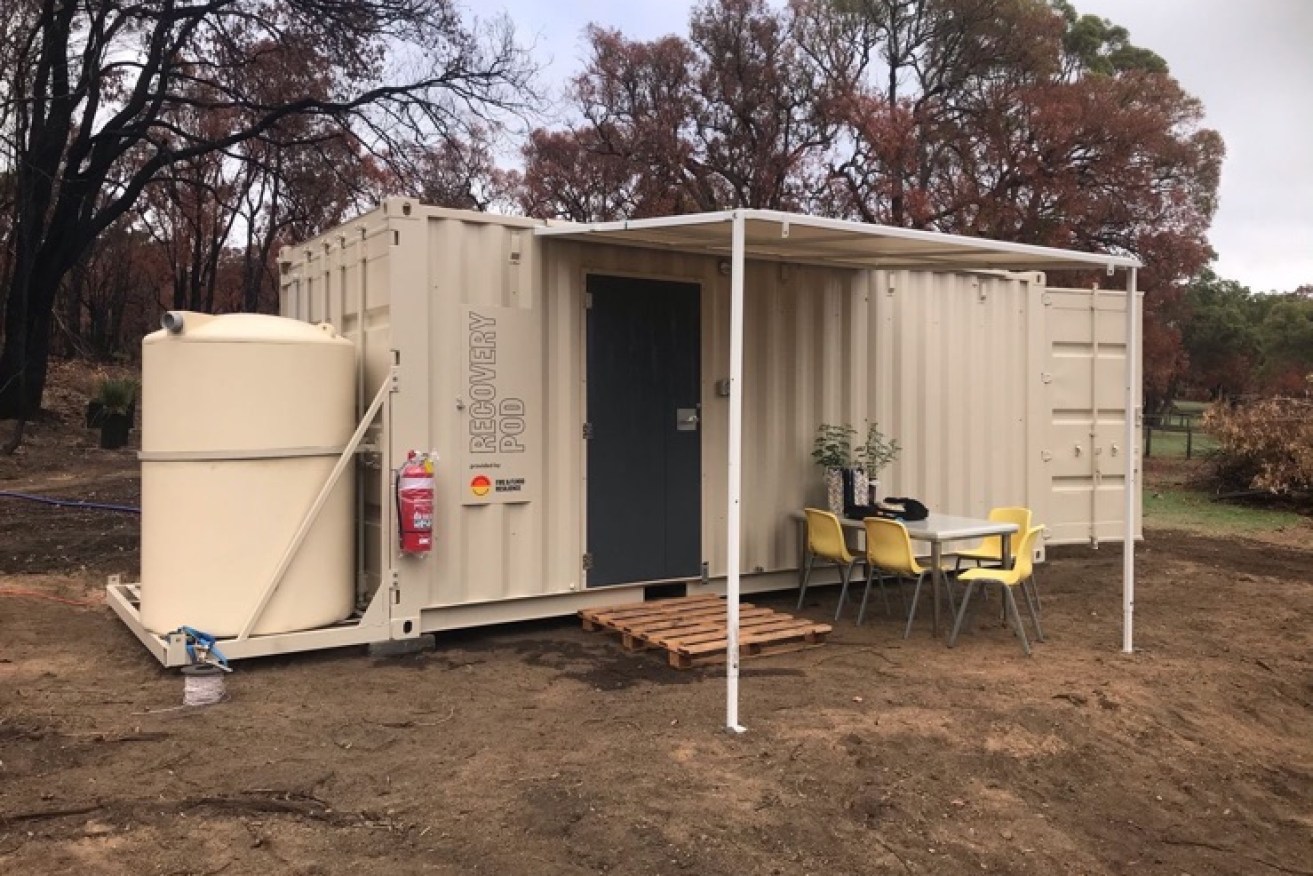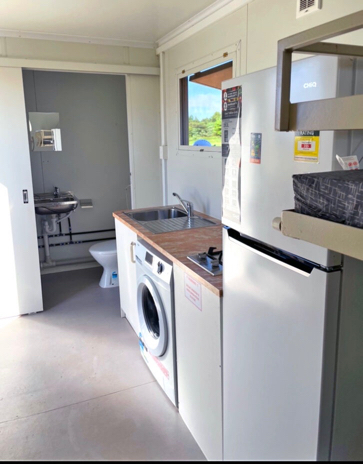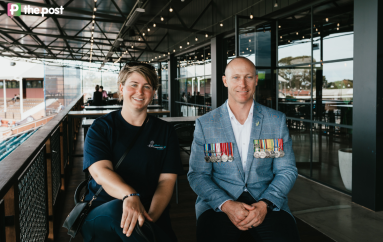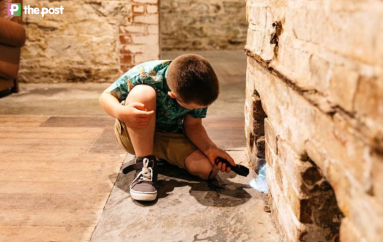Finding shelter from an unfolding social disaster
An emergency response and lateral thinking is needed to accommodate people and families locked out of rental housing and home ownership, argues Alice Clark.

Recovery pods used to shelter people left homeless after the Kangaroo Island bushfires. Photo supplied.
When a natural disaster occurs in Australia, we don’t blame people for being in the wrong place at the wrong time.
Quite the opposite. We generously throw open our hearts, our wallets and sometimes even our homes and show the victims great sympathy. The focus of the sympathy is on people who have lost their homes through no fault of their own.
Governments quickly establish shelters so people have a place to sleep. Food, clothes and support are provided. Financial assistance becomes available, and in some instances, temporary housing is supplied. Temporary dwellings may not be ideal in the long term but they mean that people can be safe, store what belongings they have and prepare meals.
Experiencing a bushfire or a flood would be very traumatic and victims absolutely deserve our compassion. I do not discount the experiences of people who have lived through them. Though I can’t help but think of people who are locked out of the private rental market right now, too. They have also ‘lost’ their homes, through no fault of their own.
For many, this situation is a new experience. They may have successfully moved from rental to rental in the past or been long term tenants in the same place. But now there are thousands of families across the country living with the rental crisis. Some are living in tents, some are sleeping in cars or couch surfing. Our rental crisis isn’t a natural disaster – but it is still a disaster.
House prices have skyrocketed and the private rental market has collapsed. These are not problems that individuals have created through not meeting their rental tenancy obligations. There is just not enough stock to meet demand. It should come as no surprise with half a million Australians returning home from overseas during the pandemic.
There was a real affordability problem for low income households before Covid, but now we have such low vacancy rates there is a bigger problem that affects people across a range of wider household incomes and demographics.
My mind also turns to the thousands of people experiencing homelessness in this country. Sometimes, all their worldly belongings fit into a single, small backpack. They too have lost their homes and lost everything. Our crisis beds are always full, and we spend millions on hotel rooms every year for hundreds of families who have nowhere to go. They are trapped.
Despite the best efforts of our tireless homelessness workforce, people may live that way for some time or sadly, never recover, we can’t achieve the housing outcomes we need because of the lack of social housing and private rentals.
Our rental crisis isn’t a natural disaster – but it is still a disaster.
Bushire affected farmers on Kangaroo Island were assisted by a shipment of innovative Minderoo Foundation Fire Fund “recovery pods”.

A Minderoo Foundation Fire Fund recovery pod used after the Kangaroo Island bushfires. Photo supplied
The recovery pods were developed to provide practical base camps, for work and temporary accommodation, while people moved towards longer term rebuilding and repair.
The South Australian Housing Authority assisted with the transport of the pods produced by South Australian manufacturer, Australian Portable Camps. People now have temporary shelter and living spaces, while they live with trauma and grapple with rebuilding or repairing their homes.
The pods can be completely off the grid, including sewerage, water and power. They can be collected and re-used when they are no longer needed.
The New South Wales Government has also initiated temporary accommodation on public land as one form of flood relief. In another example, a partnership between QBuild, the Department of Education and Fleetwood Australia mobilised a skilled emergency flood relief team to provide new school buildings at Rocklea State School in Queensland.
Amazingly, the project was pulled off in just two and a half weeks. Fleetwood also have a manufacturing facility in South Australia and can supply work camp style accommodation and stand-alone properties.
My question is, why can’t we apply the same temporary shelter responses for all people – the flood victims, renters and people experiencing homelessness? It seems we still inherently blame some people for their own circumstances, despite structural causes.
Are renters to blame for an overheated housing market and a surge in demand? Can we blame the children whose parents are experiencing homelessness for their situation? Of the 290,000 Australians who received homelessness services last year, did you know that 40% are children?
We seem to be in denial about homelessness. We don’t seem to be able to connect the dots between domestic violence and homelessness, or about illnesses and accidents that can happen to anyone. It’s time to change the narrative and change the actions we are prepared to take as a society to include everyone who has lost their home, through events outside of their control.
Our crisis beds are always full, and we spend millions on hotel rooms every year for hundreds of families who have nowhere to go. They are trapped
Shelter SA has been exploring the use of modular dwellings recently for both temporary quick build initiatives and longer-term housing. There are manufacturers right here in South Australia who have supplied temporary structures to natural disaster zones locally and interstate. They are willing and able to contribute to housing supply.
As a temporary response, we could rapidly create rental villages. Dwellings can be very quickly prepared and delivered. They can be removed when either the demand for them subsides or the land they sit upon is needed for something else because they can be off the grid.
We know that temporary village living is not suitable for everyone, but our real estate agents and not for profit housing providers, adept at screening tenants and allocating rentals, could assist in tenancy management. Matching suitable tenants and assessing affordability would be key and just like living in a block of units, respectful neighbours would be important. People would have a safe place to sleep and store their personal belongings.
State government is in a prime position to supply vacant land for quick build projects over the coming years as the New South Wales Government has done, to immediately alleviate the pressure on South Australian renters. If the state government identified a suitable site and initiated an expression of interest process, they could invite industry to supply solutions. However, private landowners and developers with temporarily vacant land could get on board too!
Another option might be to follow the Western Australian Government initiative. They have established a modular housing provider panel, to collectively address their housing challenges, and I’d like to see the same thing happen here. We should be looking at all options for quick, temporary builds, longer term housing and the way we use publicly owned land.
We could and should add to the supply of temporary accommodation while we endure the long wait for new dwellings. Nobody is building rental housing at the scale it is needed and we are constantly hearing that new construction is delayed.
To get us through the next few years, we need innovation. I would love to see our new state government meet the rental disaster challenge head on.
Dr Alice Clark is executive director of Shelter SA




